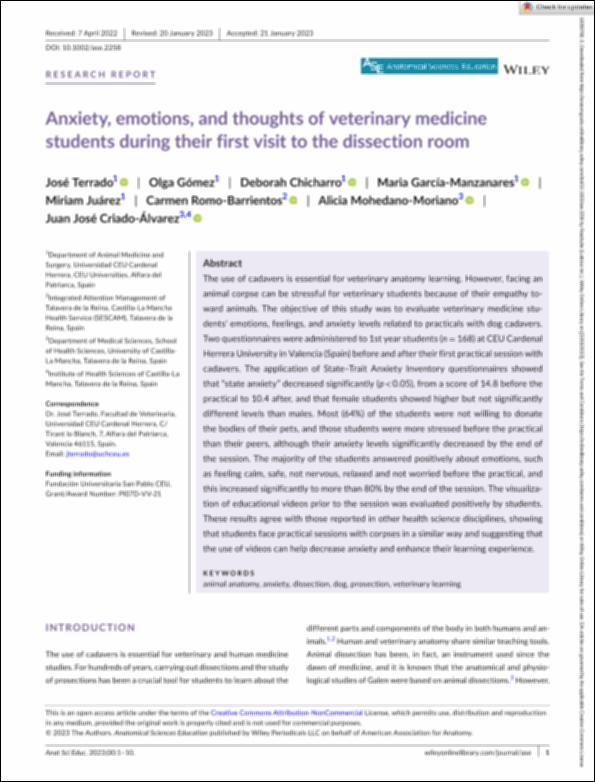Por favor, use este identificador para citar o enlazar este ítem:
http://hdl.handle.net/10637/14165Anxiety, emotions and thoughts of veterinary medicine students during their first visit to the dissection room
| Título : | Anxiety, emotions and thoughts of veterinary medicine students during their first visit to the dissection room |
| Autor : | Terrado Vicente, José Gómez Roda, Olga Chicharro Alcántara, Deborah García Manzanares, María Dolores Juárez Cuevas, Miriam Romo Barrientos, Carmen Mohedano Moriano, Alicia Criado Álvarez, Juan José |
| Materias: | Estrés en los estudiantes - Enseñanza universitaria.; Stress in students - Higher (Education); Anatomía veterinaria - Aprendizaje.; Veterinary anatomy - Knowledge and learning.; Ansiedad.; Anxiety.; Dissection.; Disección. |
| Editorial : | John Wiley & Sons |
| Citación : | Terrado, J., Gómez, O., Chicharro, D., García-Manzanares, M., Juárez, M., Romo-Barrientos, C., Mohedano-Moriano, A. & Criado-Álvarez, J. J. (2023). Anxiety, emotions, and thoughts of veterinary medicine students during their first visit to the dissection room. Anatomical Sciences Education, vol. 16, i. 3 (may.-jun.), pp. 547-556. DOI: https://doi.org/10.1002/ase.2258 |
| Resumen : | The use of cadavers is essential for veterinary anatomy learning. However, facing an animal corpse can be stressful for veterinary students because of their empathy toward animals. The objective of this study was to evaluate veterinary medicine students' emotions, feelings, and anxiety levels related to practicals with dog cadavers. Two questionnaires were administered to 1st year students (n = 168) at CEU Cardenal Herrera University in Valencia (Spain) before and after their first practical session with cadavers. The application of State–Trait Anxiety Inventory questionnaires showed that “state anxiety” decreased significantly (p < 0.05), from a score of 14.8 before the practical to 10.4 after, and that female students showed higher but not significantly different levels than males. Most (64%) of the students were not willing to donate the bodies of their pets, and those students were more stressed before the practical than their peers, although their anxiety levels significantly decreased by the end of the session. The majority of the students answered positively about emotions, such as feeling calm, safe, not nervous, relaxed and not worried before the practical, and this increased significantly to more than 80% by the end of the session. The visualization of educational videos prior to the session was evaluated positively by students. These results agree with those reported in other health science disciplines, showing that students face practical sessions with corpses in a similar way and suggesting that the use of videos can help decrease anxiety and enhance their learning experience. |
| Descripción : | Este artículo se encuentra disponible en la página web de la revista en la siguiente URL: https://anatomypubs.onlinelibrary.wiley.com/doi/epdf/10.1002/ase.2258 |
| URI : | http://hdl.handle.net/10637/14165 |
| Derechos: | http://creativecommons.org/licenses/by-nc/4.0/deed.es |
| ISSN : | 1935-9772 1935-9780 (Electrónico) |
| Cubierto por: | Acuerdo Transformativo - 2023 |
| Fecha de publicación : | 26-ene-2023 |
| Centro : | Universidad Cardenal Herrera-CEU |
| Aparece en las colecciones: | Dpto. Medicina y Cirugía Animal |
Los ítems de DSpace están protegidos por copyright, con todos los derechos reservados, a menos que se indique lo contrario.


